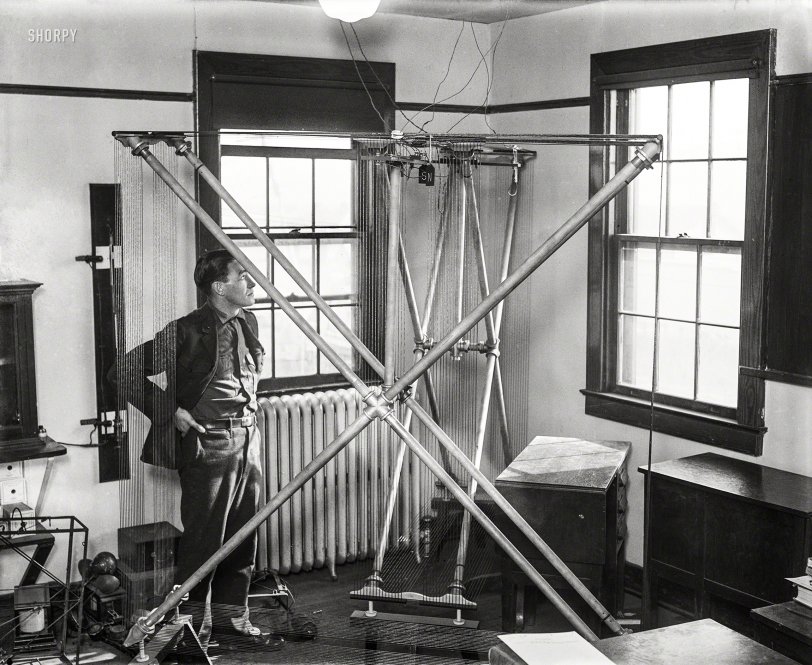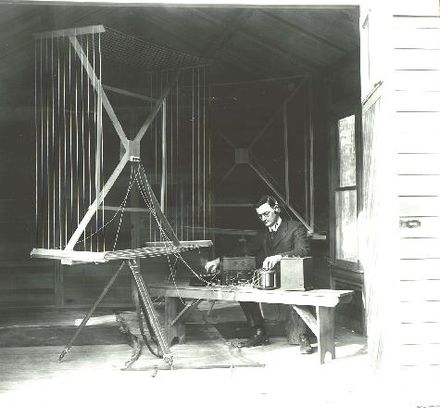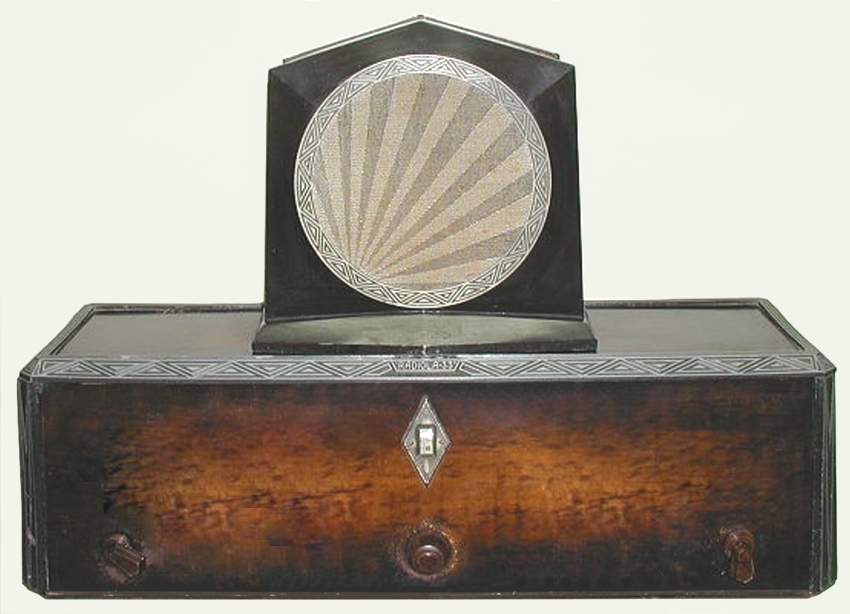


Framed or unframed, desk size to sofa size, printed by us in Arizona and Alabama since 2007. Explore now.
Shorpy is funded by you. Patreon contributors get an ad-free experience.
Learn more.

- Baldwin 62303
- Baldwin VO-1000
- Cold
- No expense spared
- Tough Guys
- Lost in Toyland
- And without gloves
- If I were a blindfolded time traveler
- Smoke Consumer Also Cooks
- Oh that stove!
- Possibly still there?
- What?!?
- $100 Reward
- Freeze Frame
- Texas Flyer wanted
- Just a Year Too Soon
- WWII -- Replacing men with women at the railroad crossing.
- Yes, Icing
- You kids drive me nuts!
- NOT An Easy Job
- I wonder
- Just add window boxes
- Icing Platform?
- Indiana Harbor Belt abides
- Freezing haze
- Corrections (for those who care)
- C&NW at Nelson
- Fallen Flags
- A dangerous job made worse
- Water Stop
Print Emporium
Well-Received: 1929

Washington, D.C., 1929. "Radio with wire-loop antenna." Harris & Ewing Collection glass negative. View full size.
Barometric
I am of the opinion that this is a weather-related facility, perhaps associated with the early National Bureau of Standards, or the Naval Obervatory which came before it.
By the man's right elbow is a precision mercury barometer - one of which I have hanging on the wall in my office - if it is not that exact model it is very similar, and hails from the same era. It is meant to be quite accurate, and I calibrate it by phoning the local airport to get the 'altimeter reading'. The upper window has a scale in inches adjacent to it, marked from 29.0 to 31.5, with a vernier to interpolate the exact measurement. It looks like there are either lamps to help read the meniscus of the mercury, and set the vernier fiducials, or they might even be photocells, which, when interrupted, could sound an alarm, etc. They seem to be wired into the large wooden glass-fronted cabinet on the wall.
The large loop antennae are set up for direction-finding - maybe a receiver for early balloon-borne "radiosonde" transmitters? Lightning locators? Seeing the apparatus they are connected to would shed light on their purpose.
The "strip recorders" are in fact ambient atmosphere recorders - there is a paper chart attached to the cylinder run by clockwork, and they record temperature, humidity, and pressure - using ink-pen nibs and ink reservoirs. Temperature is measured by a bimetal element, pressure using a flexible round metal bellows called an "anaeroid capsule," and humidity using stretched horsehair - having the quality of changing its length in relation to the amount of water it has absorbed. This hair assembly is visible protruding from the recorder on the right.
I have three of these lovely instruments as well, all restored and working, although they are retired and not in use - blame the Davis Instrument company for that.
The round things on and near the recorder on the floor might be anemometer cups - attached to a vertical shaft they spin at a known rate in the wind, and generate a voltage that is an analog of the rotation rate, which drives a suitable indicator at a remote location.
And: Happy New Year to Shorpydom - and thank you Dave and tterrace for all your hard work!
More About Seeking Than Listening
Actually, I believe what we are looking at are the large coils of a wireless direction finder. You can see a similar, but earlier (1919), device in the image from the National Bureaus of Standards. Learn more here: http://www.wikiwand.com/en/Bellini–Tosi_direction_finder#/References

Uniform
I would hazard that is a Marine, or at least, he is wearing a Marine post-1926 tunic with rolled-flat collar the globe and anchor on the lapels.
Not sure why he is not wearing a tie tucked in, but that may have been acceptable for a non-dress. Or being a technical type busy stringing an antenna.
Ground control to Major Tom
Take your protein pills and put your helmet on.
I'll bet he could have reached outer space with that thing.
Size of antenna
Regarding the size of the antenna, this is small for the time, as it's probably a 10 or 20 meter band (28/14 MHz) shortwave antenna that was pretty new in 1927. He may be in a corporate or university lab.
The tiny antennas you think of today are often fairly heavily impedance matched to work, and they're for the FM band of 88-108 MHz, about 4-8x the frequency and 1/4 to 1/8 the wavelength of this gentleman's then-state-of-the-art configuration.
And I won't even get into the microwave stuff!
Can I get Duluth?
Duluth, Bucko? You can get Tierra Del Fuego!
Harptenna.
I think Harpo could play a tune on that thing.
Tight Fit
This helps explain why so few cars had radios at the time.
Probably a Pro
The strip recorder visible in the lower left hand corner would suggest this was a research installation of some kind.
LF Stations
Radio was still experimental in the 1920s. You could find many stations transmitting well below 500kHz. These would require larger antennas to receive them.
Here is an interesting article about using an early 1920s radio to log low frequency signals.
Needed items
He looks like he's making a mental list of what he'll need at Radio Shack.
All that work
And I could have just connected to the radiator and had the whole building as an antenna.
What is not visible unless you pop for the 'full size' view, is that there are multiple threads of wire wrapped around the four corners in both directions.
All I know about antennae is that 'bigger is NOT always better', and a stronger signal is obtained when matching 1/4, 1/2, or full size of the radio wave. Don't know what happens with all the parallel strands of wire.
Neat
Nice how he got it tucked into the corner. Our local art gallery has something like this out on its front lawn.
It's no joke
Indeed a radio antenna was a significant undertaking. If you want proof, watch Stan and Ollie in Hog Wild (1930), in which they attempt to put up a radio antenna on the roof of Hardy's house so that Ms. Hardy can get Japan. Needless to say, she never gets Japan.
Calling Harry Partch
I believe I could use this to perform an evening of experimental string music.
Audience of One
I'm fairly certain the wires from this setup lead into the next room where Miss Fisch is listening.
Test results
Wow! I just picked up WLS in Chicago! Maybe I can get the WSM Barn Dance in Nashville tonight!
Wish I had a crystal set like that
Man, that took some dedication to put together.
Obviously a bachelor.
Who knew?
I guess in those days, you had to be both an electrician and a plumber if you wanted radio!
A-Plumbing We Will Go
Looks like Curly's handiwork in this episode of the Stooges. Happy New Year!
Old Iowa House attic
In 1964 when I was in college in Iowa I had a job clearing out houses when the elderly resident had died. One house I was working on had a wire coming out of the wall connected to a very old radio. I went up to the attic and found it strung with wire.
There was a faded banner hung across the parlor: "Where and with whom will you spend eternity?" We laughed and went out to buy our Falstaff beer.
In the early days of radio (1920s), stations were often quite distant from the general public and few transmitted with a lot of power. For good reception in rural areas and most small towns, an attic or external antenna was required. A good antenna would usually be about 100 feet, insulated on both ends, strung up on the roof, tall poles or from house to barn with a downlead in wire connected to the radio. Of course a lightning arrester would be part of the installation. The wire's gauge is not important except it must be strong enough to support itself. Copper is best. Bare copper wire works well and the best stuff was stranded around a steel center support cable, which helped keep it from stretching.
Nearly all US built radio receivers made from the early days to the late 1930s required an external "long wire" antenna. Most sets made after the late 1920s had one or more terminals on the rear of the chassis or a pair of wires hanging out the rear. (Photo of 1929 Radiola 33 w/100B speaker)
No wife!
I bet there's no wedding ring on his finger!
It's going to take a while.
To crochet a cover for this baby.
I Can Hear Russia From My House
It looks like two antennas that he can select direction either latitudinal or longitudinal. Note the N/S tags.

























On Shorpy:
Today’s Top 5